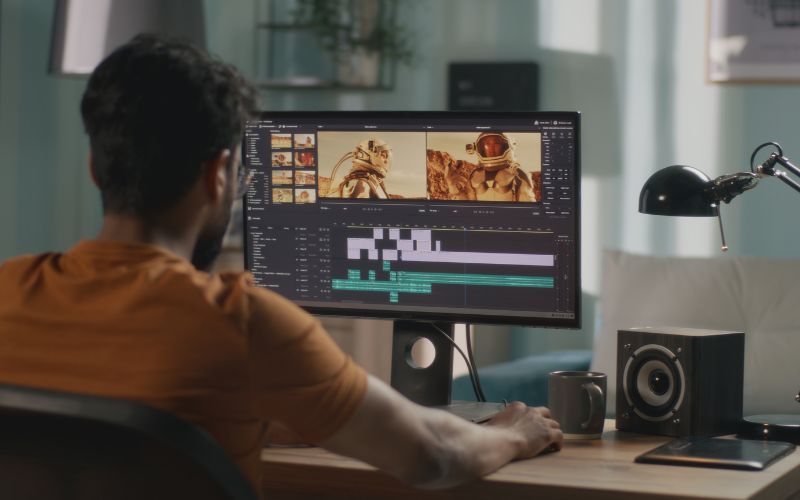Video editing is an all-purpose skill that can transform raw video into a film work of art. Whether you want to edit YouTube videos, make short films, or become a video creator, the right methods can make all the difference between success and failure. But for beginners, editing can be scary. The sheer volume of tools, effects, and software features can be intimidating.
Don’t be afraid! You can learn the art of video editing step by step with the right approach. Let’s find out what video editing is and then the best tips to start!
What is Video Editing?
Video editing is the process of refining raw footage by adding effects, transitions, sound, and enhancements to make it visually appealing. Editors remove unwanted items, arrange clips, change lighting, and refine the video to make an excellent story.
There are various tools and software that professionals utilise to enhance video quality. Whether it is for film, YouTube, social media, or advertisements, video editing makes content engaging and professional.
According to data from the US Bureau of Labor Statistics (BLS), there will be a 12% increase in demand for video editors globally between 2023 and 2026. In addition, the majority of businesses and marketers use videos more than any other media to promote their goods and services. Additionally, the report projects that the employment rate for video editors will increase by 7% between 2024 and 2032, which is undoubtedly a respectable figure. It will benefit many in India, as we are the fifth largest economy.
Okay, now let’s explore the best tips on how beginners can master video editing!
Best Video Editing Tricks for Beginners
1. Choosing the Right Editing Software
Your editing software determines your workflow. The top recommendations are the following:
- Adobe Premiere Pro: Industry-level software with pro features.
- Final Cut Pro: Great for Mac users, with professional-grade tools.
- DaVinci Resolve: Great for colour grading and pro editing.
- CapCut or iMovie: Perfect for beginners who love a simple interface.
Start with user-friendly software and progress to advanced tools after gaining confidence.
2. Organise Your Files Before Editing
Disorganised folders slow down your editing. Organise separate folders for the following:
- Raw Footage: All recorded clips.
- Music & Sound Effects: Background music and sound effects.
- Graphics & Overlays: Text animations, logos, and visuals.
- Final Exports: Finished projects ready for publishing.
Having everything organised will save time and frustration down the line.
3. Keep Your Storytelling Simple
Video editing is storytelling. Don’t overdo it with too many distracting effects. Keep it simple with the following:
- A clear beginning, middle, and end.
- Seamless transitions between clips.
- Emotions that appeal to the audience.
A fantastic edit should be seamless and focus on the message and not showy effects.
4. Save Time Using Keyboard Shortcuts
Learning keyboard shortcuts will speed up your editing. Some essentials are the following:
- Ctrl + Z (Undo): Fix mistakes in a snap.
- Spacebar (Play/Pause): Play the video at once.
- C (Cut Tool): Cut clips in a jiffy.
- V (Select Tool): Move things easily.
Editing faster leaves more time for creativity!
5. Maintain Smooth Cuts and Transitions
Jump cuts are frustrating. Use smooth transitions like the following:
- Crossfades: Transition two clips smoothly.
- Dissolves: Fade between scenes smoothly.
- Match Cuts: Transition two similar frames smoothly.
Smooth edits make videos more pleasant to watch.
6. Prioritise Audio Quality
Bad audio ruins good visuals. Improve sound quality with the following steps:
- Using clean voice recordings (no background noise).
- Putting background music for the atmosphere.
- Even audio volumes, so music is not overpowering dialogue.
The sound makes things more interesting. Pay attention!
7. Colour Correction Is a Game Changer
Raw footage looks dull. Fix the following:
- Brightness & Contrast: Make the visuals pop.
- Saturation & Hue: Enhance colours naturally.
- White Balance: Make the colours look real.
Colour grading gives a professional finish to your cuts.
8. Insert Captions & Graphics to Engage
Text elements make your videos more informative and engaging. Insert the following:
- Captions: Enable viewers to comprehend, even with sound off.
- Lower Thirds: Display names, locations, or subjects.
- Animated Titles: Maintain intro and outro interesting.
Text elements make your videos more informative and engaging.
9. Export in the Right Format
Different platforms support different video formats. When exporting, choose the following:
- MP4 for YouTube & Social Media: High quality with a small file size.
- MOV for Professional Use: Preserves high resolution.
- 4K for Ultra-HD Projects: Future-proof your content.
Test your video every time before finalising!
10. Keep Practicing & Stay Inspired
Video editing is something that improves with experience. Practice, learn lessons, and push yourself on new projects. The more you cut, the better you’ll get!
Why Take a Video Editing Course?
You can teach yourself video editing, but learning in an actual class accelerates learning. Taking a video editing course provides the following:
- Hands-on practice using pro-grade software.
- Individual guidance from industry-experienced editors.
- Portfolio project assignments to showcase skills.
- Classmate and mentor meetup opportunities.
If you want to become a pro video editing course learner, enrolling in a professional program will direct you to success.
What Video Editing Course Contains?
A professional 96-hour video editing course in 6 months includes the following:
Module 1: Vector & Raster Graphics (16 Hours)
- Learn Adobe Photoshop & Illustrator.
- Understand image editing, vector illustrations, and design basics.
Module 2: Visual Communication using After Effects (30 Hours)
- Motion graphics, transitions, and text animation.
- Become a master of visual effects design methods.
Module 3: Brand Communication Creation (34 Hours)
- Training in Adobe After Effects & Premiere Pro.
- Create real-life projects in digital marketing.
Module 4: Video Editing & Sound Design (16 Hours)
- Advanced Adobe Premiere Pro & Adobe Audition.
- Learn sound mixing, syncing voice, and telling stories through editing.
This course in professional video editing helps you gain hands-on skills that make you employable.
Why Choose Moople Academy for Video Editing?
Moople Academy is a great place to learn video editing. Here’s why:
- We offer real projects for practical training.
- Our industry-experienced expert mentors.
- Internship and job support after completing the course.
- Our industry-standard labs with the latest editing software.
If you’re serious about becoming a professional video editor, Moople Academy is the right place to start!
Conclusion
Video editing is a thrilling profession that combines technology and creativity. Anyone can learn the art of video storytelling with the right training and skills. Begin with simple techniques, try various tools, and continue learning.
If you want to convert your interest into a career, enrolling in a video editing course is the best next step. Start now with Moople Academy and create visual magic that claims the world’s attention!
FAQs
Q1. How long would it take to learn video editing?
The duration would vary with the complexity of the software and how much experience you wish to attain. Beginners could learn to do basic edits in a couple of weeks, but advanced editing skills would take six months of practice and instruction.
Q2. Would I require a high-performance computer for video editing?
Not necessarily! Newcomers can begin with simple editing software on a regular computer. But for professional editing, a machine with a decent processor, plenty of RAM, and a dedicated graphics card will provide seamless performance.
Q3. Any possibility of making money on the side if I become a freelance video editor?
Definitely! The professional options for video editing are simply amazing in terms of terrific money-making opportunities. Editors often find work through brands, businesses, and content creators seeking to bring their YouTube videos, ads, social media, and films into focus. Provided you have the skills, you can earn stable money through this freelance work.
Q4. Can an editor go pro without having taken a course?
Yes, you can teach yourself. However, there are many benefits of enrolling in one such course: practical work experience, professional tools, guidance from an instructor, and portfolio-building opportunities. Plus, it will shorten the duration of learning and enhance your chances of getting paid well.

